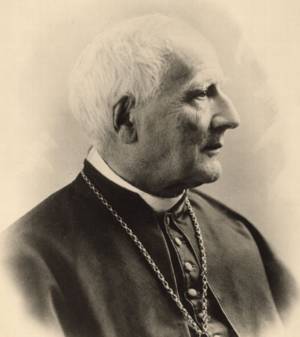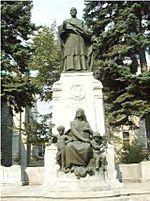Louis-François Richer Laflèche facts for kids
Quick facts for kids Louis-François Richer Laflèche |
|
|---|---|
| Bishop of Trois Rivières | |
 |
|
| Diocese | Trois-Rivières |
| Enthroned | April 30, 1870 |
| Reign ended | July 14, 1898 |
| Predecessor | Thomas Cooke |
| Successor | François-Xavier Cloutier |
| Other posts | Coadjutor Bishop of Trois Rivières |
| Orders | |
| Ordination | January 7, 1844 |
| Personal details | |
| Born | September 4, 1818 Sainte-Anne-de-la-Pérade, Lower Canada |
| Died | July 14, 1898 (aged 79) Trois-Rivières, Quebec |
Louis-François Laflèche (born September 4, 1818 – died July 14, 1898) was an important Catholic bishop in Trois-Rivières, Canada. He was known for his work as a missionary and his strong beliefs.
Contents
His Early Life and Education
Louis-François Laflèche was born on September 4, 1818, in Sainte-Anne-de-la-Pérade. His family had the last name Laflèche because their ancestor came from a place in France called La Flèche. His grandmother on his mother's side was Métis.
From 1831 to 1839, Laflèche studied at the Nicolet Seminary College in Nicolet, Quebec. After finishing his studies, he taught subjects like classics and science. He also continued to study theology, which is the study of religious faith. He became a priest on January 7, 1844.
Adventures as a Missionary
In 1844, Laflèche began working at a mission near the Red River of the North. As a missionary, he learned three Native American languages. These languages were Cree, Chipewyan, and Anishinaabe. He was the first person to write down the rules for the Chipewyan language.
In 1846, Laflèche and another priest, Father Alexandre-Antonin Taché, started the Saint-Jean-Baptiste mission at Île-à-la-Crosse. This mission was a base for their travels to other places like Green Lake and Fort Chipewyan.
Later, Laflèche was asked to become a coadjutor bishop, which is like an assistant bishop. He said no because he wasn't feeling well. So, Father Taché became the assistant bishop instead. Laflèche then helped manage the diocese when the main bishop was away.
The Battle of Grand Coteau
In 1851, Laflèche went with Métis buffalo hunters from St. François Xavier. There were 67 Métis men, plus women and children, and 200 carts. In North Dakota, they met a large group of Sioux warriors.
Laflèche, dressed in his priest's robes, helped lead the defense. The Métis fought against about 2,000 Sioux warriors. After two days of fighting (July 13 and 14), the Sioux left. They believed that the Great Spirit was protecting the Métis.
When he returned to Canada in 1856, he taught math, astronomy, and philosophy at Nicolet Seminary College. He became the president of the college in 1859.
Becoming Bishop of Trois-Rivières
In 1866, Bishop Thomas Cook of Trois-Rivières chose Laflèche to be his assistant bishop. The next year, Laflèche became a bishop. In 1870, while attending an important church meeting called the First Vatican Council, he was officially made the Bishop of Trois-Rivières.
As bishop, he used his power to speak out on important issues. For example, he tried to stop a law in New Brunswick called the Common Schools Act of 1871. This law separated the church from the education system.
Bishop Laflèche wrote many important letters and books about religion. In 1885, his diocese was divided into two parts, and he had to accept this change. He also became involved in the Manitoba Schools Question from 1890 to 1896. This was a big debate about whether Catholic schools in Manitoba should get government funding.
His Influence on Politics
As bishop of Trois-Rivières, Laflèche often gave sermons at the cathedral. He frequently talked about political and religious topics of his time. In 1876, he led a movement in Quebec that believed the church should have a strong role in society. He often disagreed with other bishops who had more liberal views.
Laflèche used his religious authority to support the Conservative Party of Quebec. He is famous for saying, "L'enfer est rouge et le ciel est bleu." This means "Hell is red and heaven is blue." Blue was the color of the Conservatives, and red was the color of the Liberals.
His influence was very strong in the 1890 provincial election. All the Conservative candidates in his area were elected, even though the Conservatives lost badly in other parts of the province.
His Final Years
Louis-François Laflèche passed away on July 14, 1898, at the age of 79. He had been a priest for 54 years and a bishop for 31 years.
Honors and Legacy
Many places and landmarks were named to honor Bishop Laflèche:
- In the Mauricie, Quebec area:
- Avenue Laflèche, in Shawinigan, Mauricie;
- Laflèche College and Rue Laflèche, in Trois-Rivières;
- Rue Laflèche, in La Tuque;
- Rue Laflèche, in Louiseville;
- Rue Laflèche, in Saint-Paulin;
- In the Greater Quebec City area:
- Rue Laflèche, in Beauport, Greater Quebec City Area;
- Rue Laflèche, in L'Ancienne-Lorette;
- Rue Monseigneur-Laflèche, in Sainte-Foy;
- Elsewhere in Quebec:
- Rue Laflèche, in Montreal;
- Rue Monseigneur-Laflèche, in Boucherville, Montérégie.
Also, the former federal voting district of Saint-Maurice—Laflèche and the village of Lafleche, Saskatchewan were named after him.


